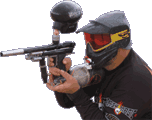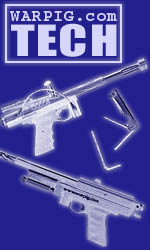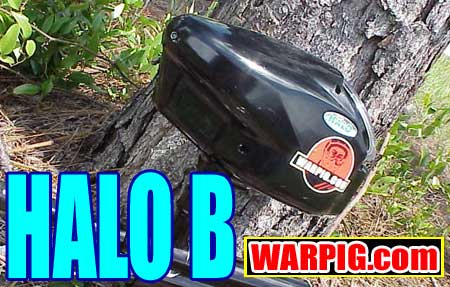  |
|
|
|
|
|
|
  |
|
|
|
|
|
|

What
do you think?
|

HALO B The Next Generation By Bill Mills Ever since its release in late 2001, the HALO from Odyssey Paintball has been appearing on more and more paintguns at major tournaments. For a look at WARPIG’s review of the original HALO, CLICK HERE. Even while the first units were moving out the door, designer Chris Goddard was already working on a more advanced, next generation HALO model. While paint jams were a rarity with the original HALO, they did sometimes happen, and Goddard found that on vertical feed paintguns the HALO could not feed as fast as when it was installed on paintguns with a powerfeed. Both issues were addressed with the HALO B.
The next major change was made in the drive cone. The HALO design uses a drive cone, a part that looks rather much like a small roulette wheel. It sits inside a catch cup, and as it spins, drives balls out into the loader’s feed neck. The new drive cone on the HALO B has two pieces, and an internal spring. The main problem the HALO, and most other hoppers had faced when installed on a vertical feed paintgun was ball-bobble. Either blowback gasses, or simply being bumped by the bolt of the paintgun as it closes, can cause the paintballs stacked in the feed tube to bounce upward back into the loader. This can mean that it will take longer for the balls to drop back into place, and then into the breech. If it takes too long, the bolt will be closing again, and end up chopping a ball.
The new arrangement puts a constant pressure on the paintballs stacked in front of the breech. There is always a constant, but gentle pressure on the paint, waiting to literally drive it into the paintgun, no longer relying on gravity. The spring system also acts as a buffer, it prevents the HALO B from over-driving paintballs, breaking them with too much pressure. With the changes to the drive system, the latching ball detent has been eliminated from the HALO design.
The way the software in the HALO B operates has also been changed. While there is still an infrared reflective sensor in the neck, that is only a part of the HALO’s activation system, and the HALO can even feed paint with the optical sensor removed or blocked. If the optical sensor does not detect a paintball in the neck, the motor will be pulsed slightly, at regular intervals. Feedback circuits both during the pulses, and normal loading operation measure the amperage drawn by the motor. If the motor hits resistance, the amperage will rise, and the control software responds by cutting power, as another way to prevent balls from being overdriven and broken.
Another very minor change was made to the HALO’s pushbutton assembly. In the original HALO, a rubber, water resistant push button nub on the back face pressed a dome microswitch on the internal circuit board when it was pushed. The set up is the same on the HALO B, except that there is a slight gap between the rubber nub and the top of the switch. This allows for much easier assembly of the HALO B after maintenance, without any alignment problems for the pushbutton.
Another option now available with the HALO are clear shells. Original HALO shells were black with clear lids. Shells are now available made of the same polycarbonate material in color choices ranging from completely clear to colored tints like blue and red. The HALO B is now the standard production
model, and is easily identified from an original HALO both by the beads
on the second anti-jam device and the fact that it is turned on by a single
press of the power button. Further identification can be made by
opening the loader, and turning the drive cone clockwise. If it springs
back, counter-clockwise, the loader is a HALO B. For customers who
purchased the original HALO, an upgrade is available factory direct for
thirty dollars.
|
| Copyright © 1992-2019
Corinthian Media Services. WARPIG's webmasters can be reached through our feedback form. All articles and images are copyrighted and may not be redistributed without the written permission of their original creators and Corinthian Media Services. The WARPIG paintball page is a collection of information and pointers to sources from around the internet and other locations. As such, Corinthian Media Services makes no claims to the trustworthiness or reliability of said information. The information contained in, and referenced by WARPIG, should not be used as a substitute for safety information from trained professionals in the paintball industry. |